MBA402 Risk Assessment Report: Property Millionaire Analysis
VerifiedAdded on 2022/11/10
|12
|2831
|164
Report
AI Summary
This report provides a comprehensive risk assessment of Property Millionaire, a mentoring services company, based on the provided case study. The assessment utilizes Simon's Risk Exposure Calculator to identify and evaluate risks related to growth, culture, and information management. The analysis delves into specific pressure points such as performance, expansion, employee inexperience, entrepreneurial risk-taking, resistance to bad news, internal competition, transaction complexity, diagnostic performance gaps, and decentralized decision-making. The report provides risk ratings for each component, revealing that the company faces significant challenges in information management and cultural practices. The conclusion highlights the need for strategic actions, including promoting team value, providing training for new employees, and restructuring organizational practices to mitigate identified risks and achieve business objectives. The report also includes recommendations for improvement, such as fostering a team-oriented environment and offering comprehensive training programs. References are included.
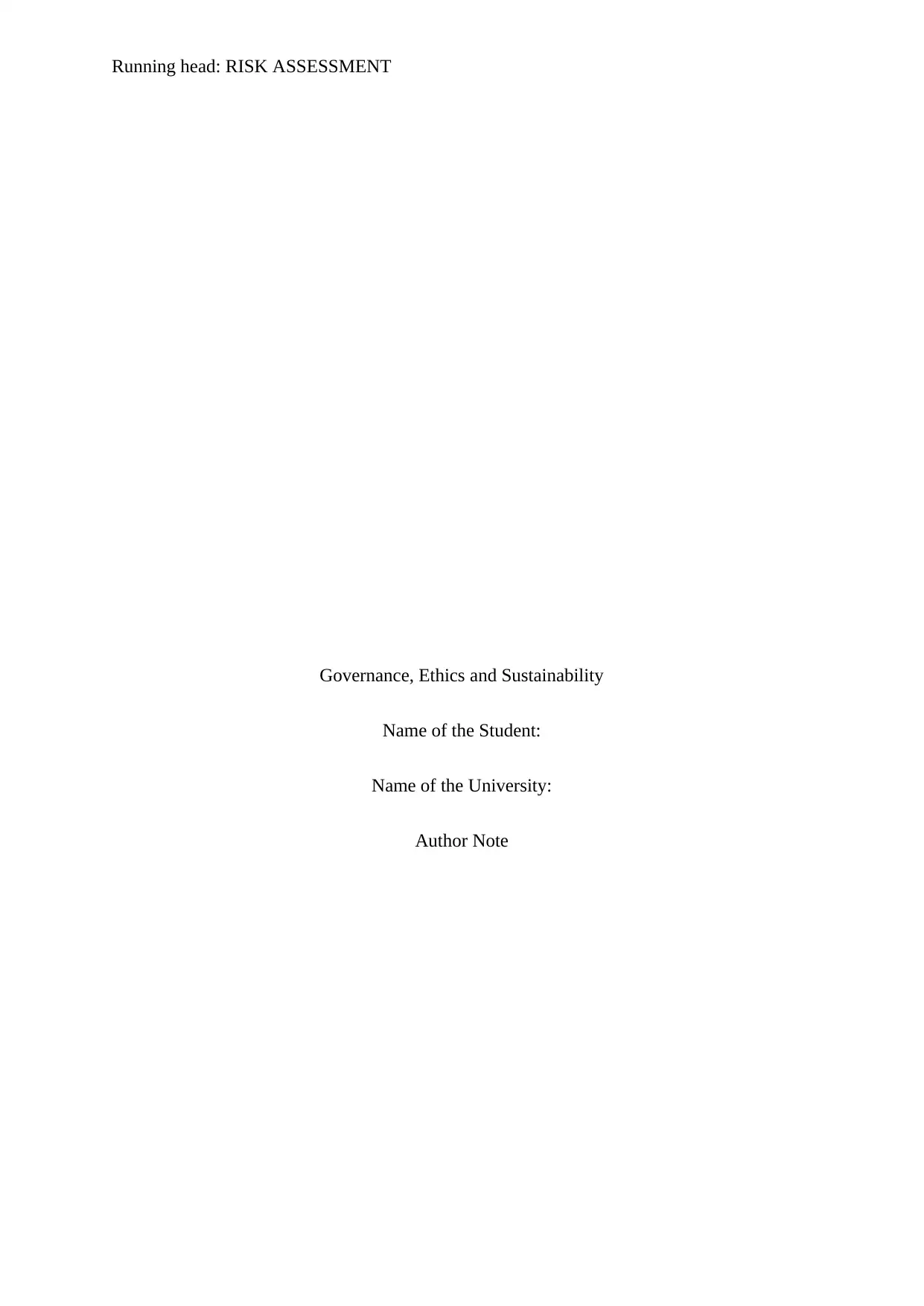
Running head: RISK ASSESSMENT
Governance, Ethics and Sustainability
Name of the Student:
Name of the University:
Author Note
Governance, Ethics and Sustainability
Name of the Student:
Name of the University:
Author Note
Paraphrase This Document
Need a fresh take? Get an instant paraphrase of this document with our AI Paraphraser

1RISK ASSESSMENT
Contents
Introduction................................................................................................................................2
Goal of Risk Assessment.......................................................................................................2
Method...................................................................................................................................2
Discussion..............................................................................................................................3
a. Growth related pressure point.........................................................................................3
Performance pressure.............................................................................................................3
Level of expansion.................................................................................................................3
Inefficiency of the employees................................................................................................4
b. Cultural pressure point........................................................................................................4
Entrepreneurial risk-taking aspect..........................................................................................4
Resistance to bad news of the employees..............................................................................4
Rate of internal competition...................................................................................................5
c. Information management pressure points...........................................................................5
Complexity and velocity in transaction process.....................................................................5
Diagnostic performance gaps.................................................................................................6
Power of Decentralised decision............................................................................................6
Conclusion..................................................................................................................................6
Recommendation........................................................................................................................8
References................................................................................................................................10
Contents
Introduction................................................................................................................................2
Goal of Risk Assessment.......................................................................................................2
Method...................................................................................................................................2
Discussion..............................................................................................................................3
a. Growth related pressure point.........................................................................................3
Performance pressure.............................................................................................................3
Level of expansion.................................................................................................................3
Inefficiency of the employees................................................................................................4
b. Cultural pressure point........................................................................................................4
Entrepreneurial risk-taking aspect..........................................................................................4
Resistance to bad news of the employees..............................................................................4
Rate of internal competition...................................................................................................5
c. Information management pressure points...........................................................................5
Complexity and velocity in transaction process.....................................................................5
Diagnostic performance gaps.................................................................................................6
Power of Decentralised decision............................................................................................6
Conclusion..................................................................................................................................6
Recommendation........................................................................................................................8
References................................................................................................................................10
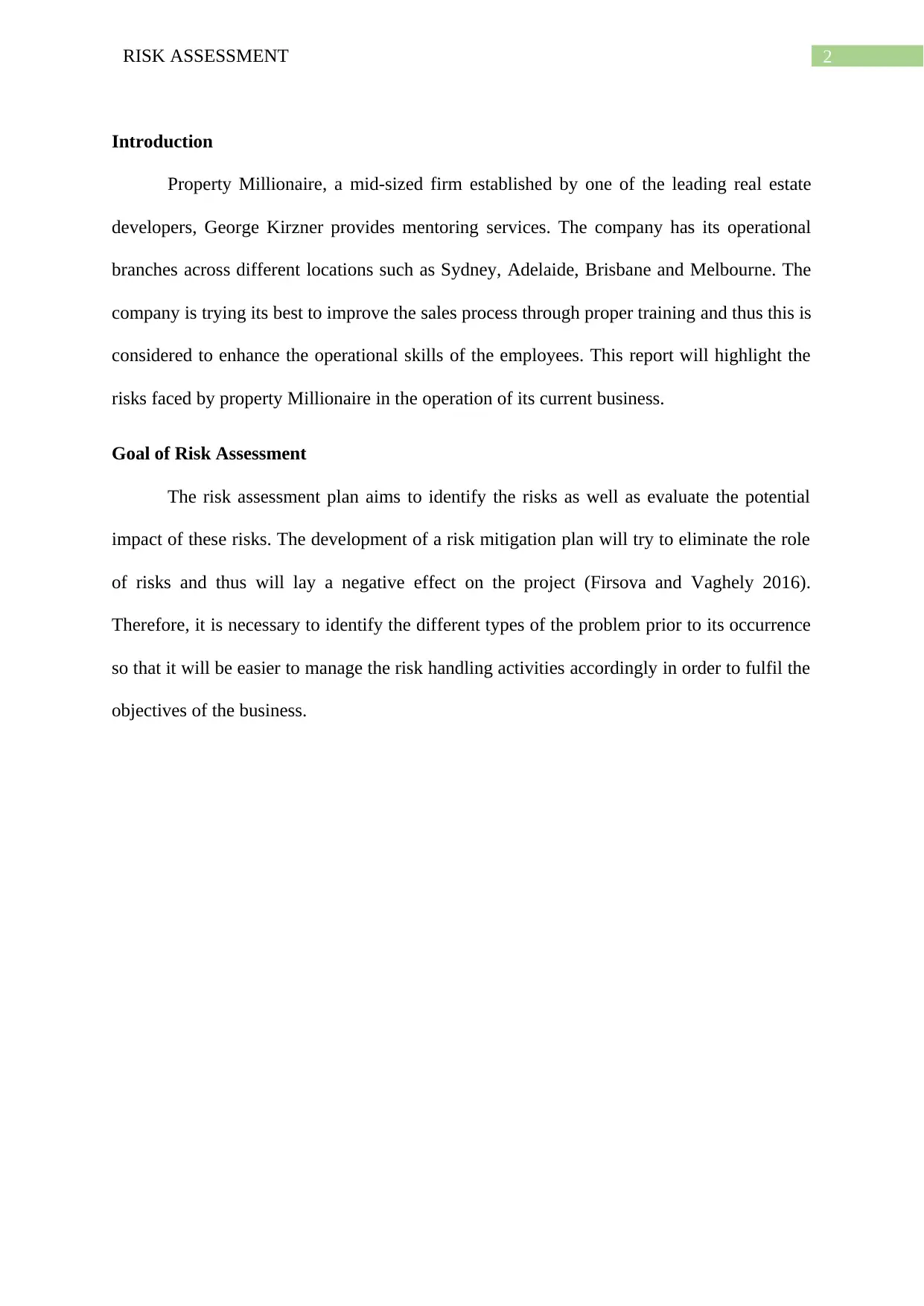
2RISK ASSESSMENT
Introduction
Property Millionaire, a mid-sized firm established by one of the leading real estate
developers, George Kirzner provides mentoring services. The company has its operational
branches across different locations such as Sydney, Adelaide, Brisbane and Melbourne. The
company is trying its best to improve the sales process through proper training and thus this is
considered to enhance the operational skills of the employees. This report will highlight the
risks faced by property Millionaire in the operation of its current business.
Goal of Risk Assessment
The risk assessment plan aims to identify the risks as well as evaluate the potential
impact of these risks. The development of a risk mitigation plan will try to eliminate the role
of risks and thus will lay a negative effect on the project (Firsova and Vaghely 2016).
Therefore, it is necessary to identify the different types of the problem prior to its occurrence
so that it will be easier to manage the risk handling activities accordingly in order to fulfil the
objectives of the business.
Introduction
Property Millionaire, a mid-sized firm established by one of the leading real estate
developers, George Kirzner provides mentoring services. The company has its operational
branches across different locations such as Sydney, Adelaide, Brisbane and Melbourne. The
company is trying its best to improve the sales process through proper training and thus this is
considered to enhance the operational skills of the employees. This report will highlight the
risks faced by property Millionaire in the operation of its current business.
Goal of Risk Assessment
The risk assessment plan aims to identify the risks as well as evaluate the potential
impact of these risks. The development of a risk mitigation plan will try to eliminate the role
of risks and thus will lay a negative effect on the project (Firsova and Vaghely 2016).
Therefore, it is necessary to identify the different types of the problem prior to its occurrence
so that it will be easier to manage the risk handling activities accordingly in order to fulfil the
objectives of the business.
⊘ This is a preview!⊘
Do you want full access?
Subscribe today to unlock all pages.

Trusted by 1+ million students worldwide

3RISK ASSESSMENT
Method
The risk valuation calculator highlights the diverse pressure points that are prevalent
in every organisation. This includes the increased level of risk, the rate of operational
expansion as well as the level of in-house competition. It is the responsibility of the
employees in the organisation to determine the level of risks of the company and thus classify
it in the safety, danger or the caution zone. This will make it easier to align with the
organizational strategies and goals in the future. It has been found that the managers of a
particular organisation will be involved in the risk exposure of the company and thus they are
held liable to calculate the risks (Simons 1999). Thus, it is important to identify the different
pressure points related to risks in the organisation. This report will carry out a detailed
analysis of Simon’s risk assessment calculator in relation to Property Millionaire.
Discussion
a. Growth related pressure point
Performance pressure
It has been found that the current organizational level is competitive and there is a
growing pressure on the employees to perform the best for the development and the growth
of the organization. There is a gradual increase in the revenue as well as the sales of Property
Millionaire over the past few years. However, there has been the development of a complex
scenario in the organisation although the employees have tried their best to perform
according to the existing organizational capability (Strelnik et al. 2015). It should be checked
that the employees have sufficient skills to fulfil the demands of the potential clients of
Property Millionaire. Depending on the rating scale of the risk calculator, Property
Millionaire can be marked with 1 point score as there is no such higher risk present in the
organisation so as to fulfil the market demand. The new employees who are recruited in the
Method
The risk valuation calculator highlights the diverse pressure points that are prevalent
in every organisation. This includes the increased level of risk, the rate of operational
expansion as well as the level of in-house competition. It is the responsibility of the
employees in the organisation to determine the level of risks of the company and thus classify
it in the safety, danger or the caution zone. This will make it easier to align with the
organizational strategies and goals in the future. It has been found that the managers of a
particular organisation will be involved in the risk exposure of the company and thus they are
held liable to calculate the risks (Simons 1999). Thus, it is important to identify the different
pressure points related to risks in the organisation. This report will carry out a detailed
analysis of Simon’s risk assessment calculator in relation to Property Millionaire.
Discussion
a. Growth related pressure point
Performance pressure
It has been found that the current organizational level is competitive and there is a
growing pressure on the employees to perform the best for the development and the growth
of the organization. There is a gradual increase in the revenue as well as the sales of Property
Millionaire over the past few years. However, there has been the development of a complex
scenario in the organisation although the employees have tried their best to perform
according to the existing organizational capability (Strelnik et al. 2015). It should be checked
that the employees have sufficient skills to fulfil the demands of the potential clients of
Property Millionaire. Depending on the rating scale of the risk calculator, Property
Millionaire can be marked with 1 point score as there is no such higher risk present in the
organisation so as to fulfil the market demand. The new employees who are recruited in the
Paraphrase This Document
Need a fresh take? Get an instant paraphrase of this document with our AI Paraphraser
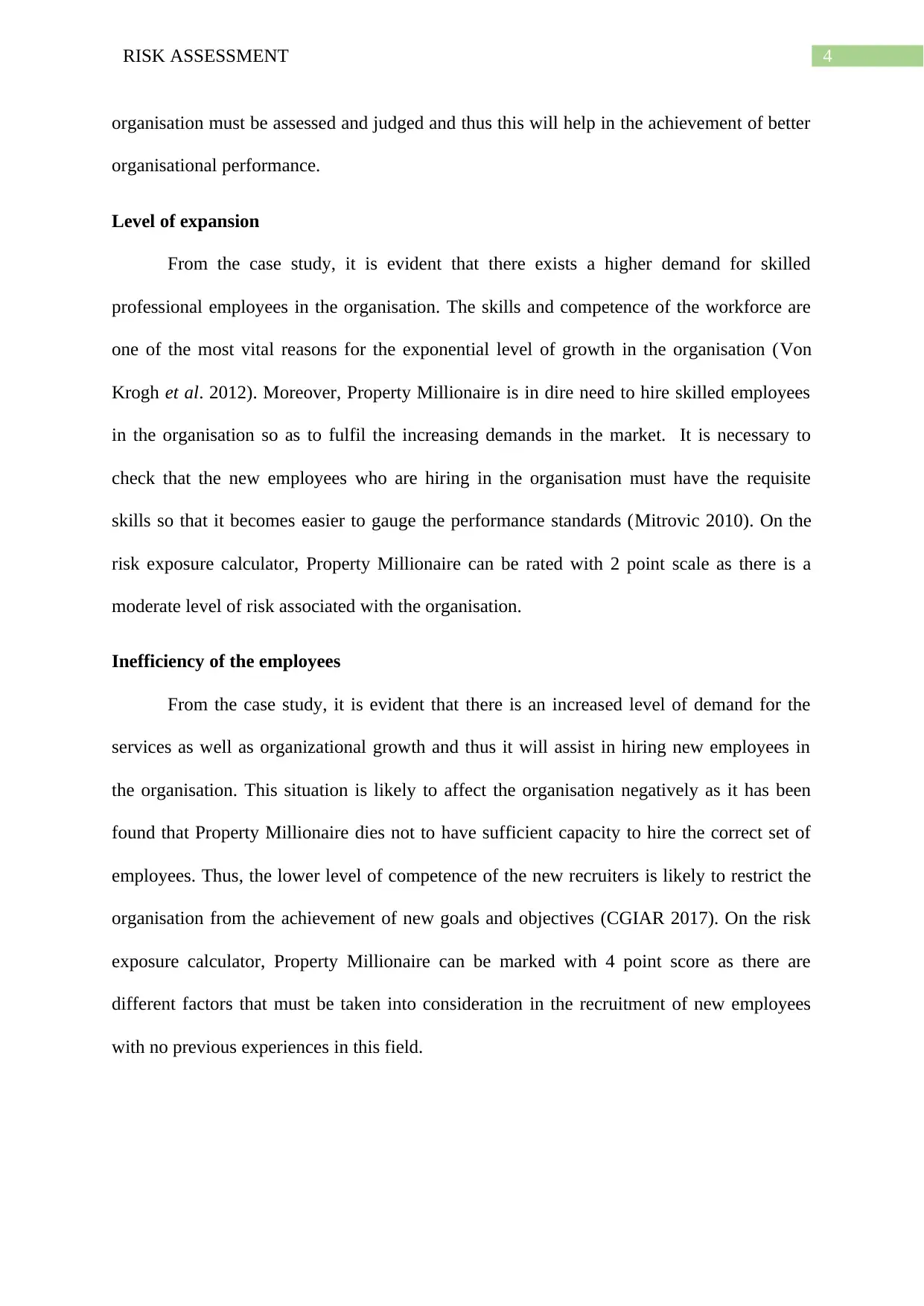
4RISK ASSESSMENT
organisation must be assessed and judged and thus this will help in the achievement of better
organisational performance.
Level of expansion
From the case study, it is evident that there exists a higher demand for skilled
professional employees in the organisation. The skills and competence of the workforce are
one of the most vital reasons for the exponential level of growth in the organisation (Von
Krogh et al. 2012). Moreover, Property Millionaire is in dire need to hire skilled employees
in the organisation so as to fulfil the increasing demands in the market. It is necessary to
check that the new employees who are hiring in the organisation must have the requisite
skills so that it becomes easier to gauge the performance standards (Mitrovic 2010). On the
risk exposure calculator, Property Millionaire can be rated with 2 point scale as there is a
moderate level of risk associated with the organisation.
Inefficiency of the employees
From the case study, it is evident that there is an increased level of demand for the
services as well as organizational growth and thus it will assist in hiring new employees in
the organisation. This situation is likely to affect the organisation negatively as it has been
found that Property Millionaire dies not to have sufficient capacity to hire the correct set of
employees. Thus, the lower level of competence of the new recruiters is likely to restrict the
organisation from the achievement of new goals and objectives (CGIAR 2017). On the risk
exposure calculator, Property Millionaire can be marked with 4 point score as there are
different factors that must be taken into consideration in the recruitment of new employees
with no previous experiences in this field.
organisation must be assessed and judged and thus this will help in the achievement of better
organisational performance.
Level of expansion
From the case study, it is evident that there exists a higher demand for skilled
professional employees in the organisation. The skills and competence of the workforce are
one of the most vital reasons for the exponential level of growth in the organisation (Von
Krogh et al. 2012). Moreover, Property Millionaire is in dire need to hire skilled employees
in the organisation so as to fulfil the increasing demands in the market. It is necessary to
check that the new employees who are hiring in the organisation must have the requisite
skills so that it becomes easier to gauge the performance standards (Mitrovic 2010). On the
risk exposure calculator, Property Millionaire can be rated with 2 point scale as there is a
moderate level of risk associated with the organisation.
Inefficiency of the employees
From the case study, it is evident that there is an increased level of demand for the
services as well as organizational growth and thus it will assist in hiring new employees in
the organisation. This situation is likely to affect the organisation negatively as it has been
found that Property Millionaire dies not to have sufficient capacity to hire the correct set of
employees. Thus, the lower level of competence of the new recruiters is likely to restrict the
organisation from the achievement of new goals and objectives (CGIAR 2017). On the risk
exposure calculator, Property Millionaire can be marked with 4 point score as there are
different factors that must be taken into consideration in the recruitment of new employees
with no previous experiences in this field.

5RISK ASSESSMENT
b. Cultural pressure point
Entrepreneurial risk-taking aspect
The core service of Property Millionaire is handling financial management seminars.
The structure and the content of the seminar are generally maintained by the consultants with
the help of innovative aspects. On the other hand, it is necessary to check that the consultants
associated in the organisation have a specific level of skills, team value as well as the
autonomy approach in the organisation (Harvard Business Review 2019). Depending on the
rating of the risk exposure calculator, Property Millionaire can be marked with 4 point score.
This indicates that there is a higher level of risk in the organisation and thus the failure for
continuous management and organization of the seminar is one of the vital reasons for lower
productivity.
Resistance to bad news of the employees
The managers are the most inspirational employees in the organisation. It is the duty
of the manager to check that there is a proper motivating culture in the organisation and thus
the employees must remain committed to organisational excellence. If the managers do not
have sufficient skills, they will fail to motivate the employees and thus keep them engaged in
the organisation. The managers who are working in Property Millionaire are unwilling to hear
the bad news from the employees (Mikes and Kaplan 2014). Further, the employees are
stressed for performing their best and thus the manager tries to restrict themselves from
listening to their true potential and capacity. The rating of the risk exposure calculator,
Property Millionaire can be marked with 4 point scale as the higher level of the psychological
pressure of the employees hampers the professional performance in the long run.
Rate of internal competition
The organisational environment of Property Millionaire is considered to be highly
competitive. The consultants are provided bonuses and royalties, thereby motivating them to
b. Cultural pressure point
Entrepreneurial risk-taking aspect
The core service of Property Millionaire is handling financial management seminars.
The structure and the content of the seminar are generally maintained by the consultants with
the help of innovative aspects. On the other hand, it is necessary to check that the consultants
associated in the organisation have a specific level of skills, team value as well as the
autonomy approach in the organisation (Harvard Business Review 2019). Depending on the
rating of the risk exposure calculator, Property Millionaire can be marked with 4 point score.
This indicates that there is a higher level of risk in the organisation and thus the failure for
continuous management and organization of the seminar is one of the vital reasons for lower
productivity.
Resistance to bad news of the employees
The managers are the most inspirational employees in the organisation. It is the duty
of the manager to check that there is a proper motivating culture in the organisation and thus
the employees must remain committed to organisational excellence. If the managers do not
have sufficient skills, they will fail to motivate the employees and thus keep them engaged in
the organisation. The managers who are working in Property Millionaire are unwilling to hear
the bad news from the employees (Mikes and Kaplan 2014). Further, the employees are
stressed for performing their best and thus the manager tries to restrict themselves from
listening to their true potential and capacity. The rating of the risk exposure calculator,
Property Millionaire can be marked with 4 point scale as the higher level of the psychological
pressure of the employees hampers the professional performance in the long run.
Rate of internal competition
The organisational environment of Property Millionaire is considered to be highly
competitive. The consultants are provided bonuses and royalties, thereby motivating them to
⊘ This is a preview!⊘
Do you want full access?
Subscribe today to unlock all pages.

Trusted by 1+ million students worldwide

6RISK ASSESSMENT
perform in the best possible way. It has been found that there is a steep level of competition
in the organisation and this is likely to affect the organisational culture (Racz et al. 2010). In
this situation, the employees will only try to fulfil the sales goal rather than focusing on the
quality work. This type of competition is considered to be ruthless and thus it is necessary to
develop an intense level of competition in the organisation (Cardona 2013). Property
Millionaire can be marked with 3 rating scale and therefore there should be provisions for
immediate strategic response in the organisation.
c. Information management pressure points
Complexity and velocity in transaction process
It can be said that the current level of business in Property Millionaire involves the
handling of complex seminars related to financial management. According to the case study,
it has been found that the managers who are associated with the organisation face difficulty in
understanding the complex language as well as analyse the technical specifications in the
organisation (Shahzad and Safvi 2010). On the other hand, the managers must not rely
entirely on the consultants in the fulfilment of a task as well as in the delivery of higher-level
service. There should be the provision of training of the managers only after the consultation
process (Zakic et al. 2016). On the risk exposure calculator, property Millionaire can be
marked with 2 rating score and therefore it is necessary to control the risk in order to prevent
danger in the organisation.
Diagnostic performance gaps
The managers of Property Millionaire has a limited level of technical competence as
well as the knowledge of the performance data. However, it has been found that the
managers basically focus on the sales figures rather than evaluating the performance and thus
it creates a gap in the diagnostic performance of the employees. In this present scenario,
perform in the best possible way. It has been found that there is a steep level of competition
in the organisation and this is likely to affect the organisational culture (Racz et al. 2010). In
this situation, the employees will only try to fulfil the sales goal rather than focusing on the
quality work. This type of competition is considered to be ruthless and thus it is necessary to
develop an intense level of competition in the organisation (Cardona 2013). Property
Millionaire can be marked with 3 rating scale and therefore there should be provisions for
immediate strategic response in the organisation.
c. Information management pressure points
Complexity and velocity in transaction process
It can be said that the current level of business in Property Millionaire involves the
handling of complex seminars related to financial management. According to the case study,
it has been found that the managers who are associated with the organisation face difficulty in
understanding the complex language as well as analyse the technical specifications in the
organisation (Shahzad and Safvi 2010). On the other hand, the managers must not rely
entirely on the consultants in the fulfilment of a task as well as in the delivery of higher-level
service. There should be the provision of training of the managers only after the consultation
process (Zakic et al. 2016). On the risk exposure calculator, property Millionaire can be
marked with 2 rating score and therefore it is necessary to control the risk in order to prevent
danger in the organisation.
Diagnostic performance gaps
The managers of Property Millionaire has a limited level of technical competence as
well as the knowledge of the performance data. However, it has been found that the
managers basically focus on the sales figures rather than evaluating the performance and thus
it creates a gap in the diagnostic performance of the employees. In this present scenario,
Paraphrase This Document
Need a fresh take? Get an instant paraphrase of this document with our AI Paraphraser
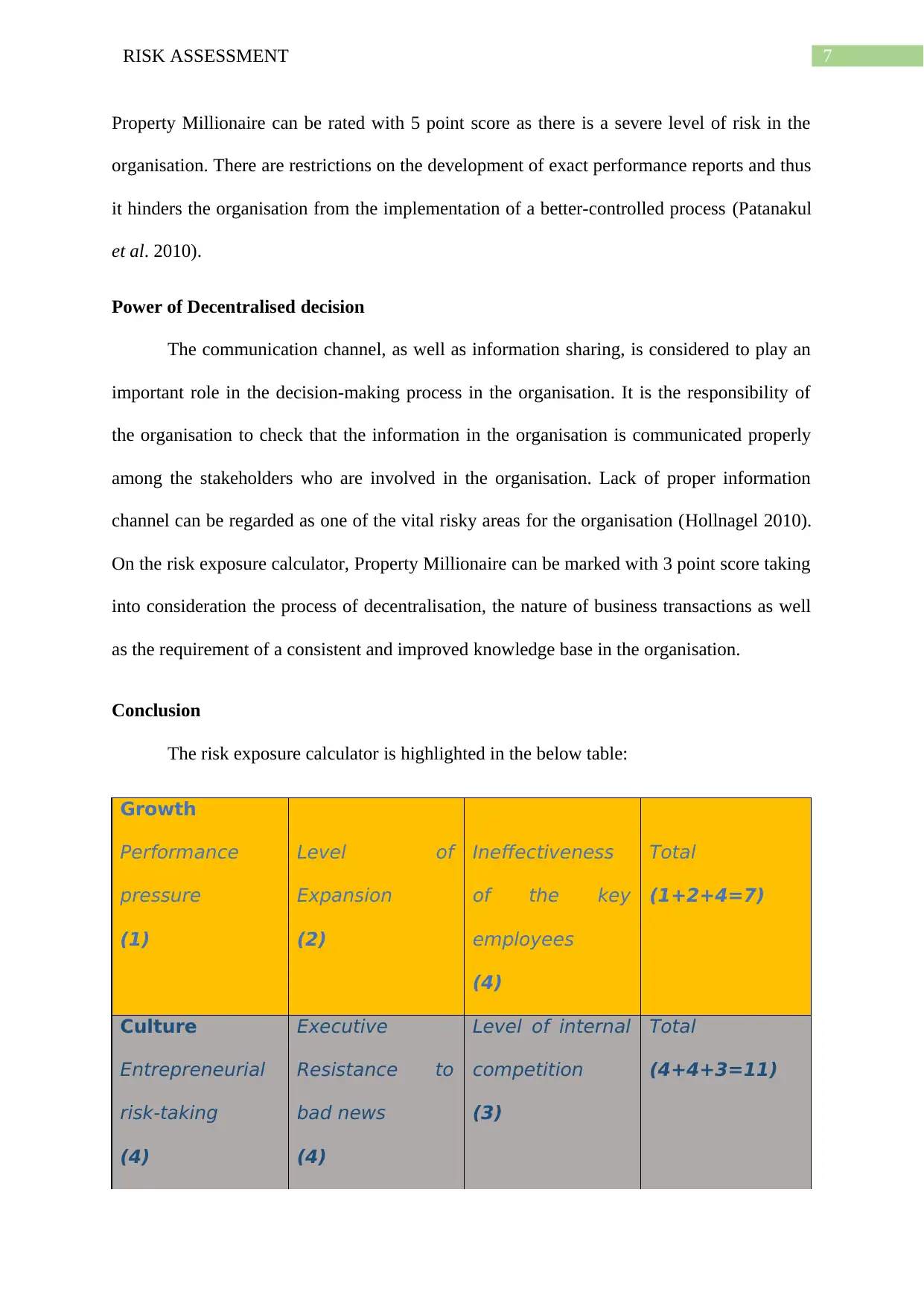
7RISK ASSESSMENT
Property Millionaire can be rated with 5 point score as there is a severe level of risk in the
organisation. There are restrictions on the development of exact performance reports and thus
it hinders the organisation from the implementation of a better-controlled process (Patanakul
et al. 2010).
Power of Decentralised decision
The communication channel, as well as information sharing, is considered to play an
important role in the decision-making process in the organisation. It is the responsibility of
the organisation to check that the information in the organisation is communicated properly
among the stakeholders who are involved in the organisation. Lack of proper information
channel can be regarded as one of the vital risky areas for the organisation (Hollnagel 2010).
On the risk exposure calculator, Property Millionaire can be marked with 3 point score taking
into consideration the process of decentralisation, the nature of business transactions as well
as the requirement of a consistent and improved knowledge base in the organisation.
Conclusion
The risk exposure calculator is highlighted in the below table:
Growth
Performance
pressure
(1)
Level of
Expansion
(2)
Ineffectiveness
of the key
employees
(4)
Total
(1+2+4=7)
Culture
Entrepreneurial
risk-taking
(4)
Executive
Resistance to
bad news
(4)
Level of internal
competition
(3)
Total
(4+4+3=11)
Property Millionaire can be rated with 5 point score as there is a severe level of risk in the
organisation. There are restrictions on the development of exact performance reports and thus
it hinders the organisation from the implementation of a better-controlled process (Patanakul
et al. 2010).
Power of Decentralised decision
The communication channel, as well as information sharing, is considered to play an
important role in the decision-making process in the organisation. It is the responsibility of
the organisation to check that the information in the organisation is communicated properly
among the stakeholders who are involved in the organisation. Lack of proper information
channel can be regarded as one of the vital risky areas for the organisation (Hollnagel 2010).
On the risk exposure calculator, Property Millionaire can be marked with 3 point score taking
into consideration the process of decentralisation, the nature of business transactions as well
as the requirement of a consistent and improved knowledge base in the organisation.
Conclusion
The risk exposure calculator is highlighted in the below table:
Growth
Performance
pressure
(1)
Level of
Expansion
(2)
Ineffectiveness
of the key
employees
(4)
Total
(1+2+4=7)
Culture
Entrepreneurial
risk-taking
(4)
Executive
Resistance to
bad news
(4)
Level of internal
competition
(3)
Total
(4+4+3=11)
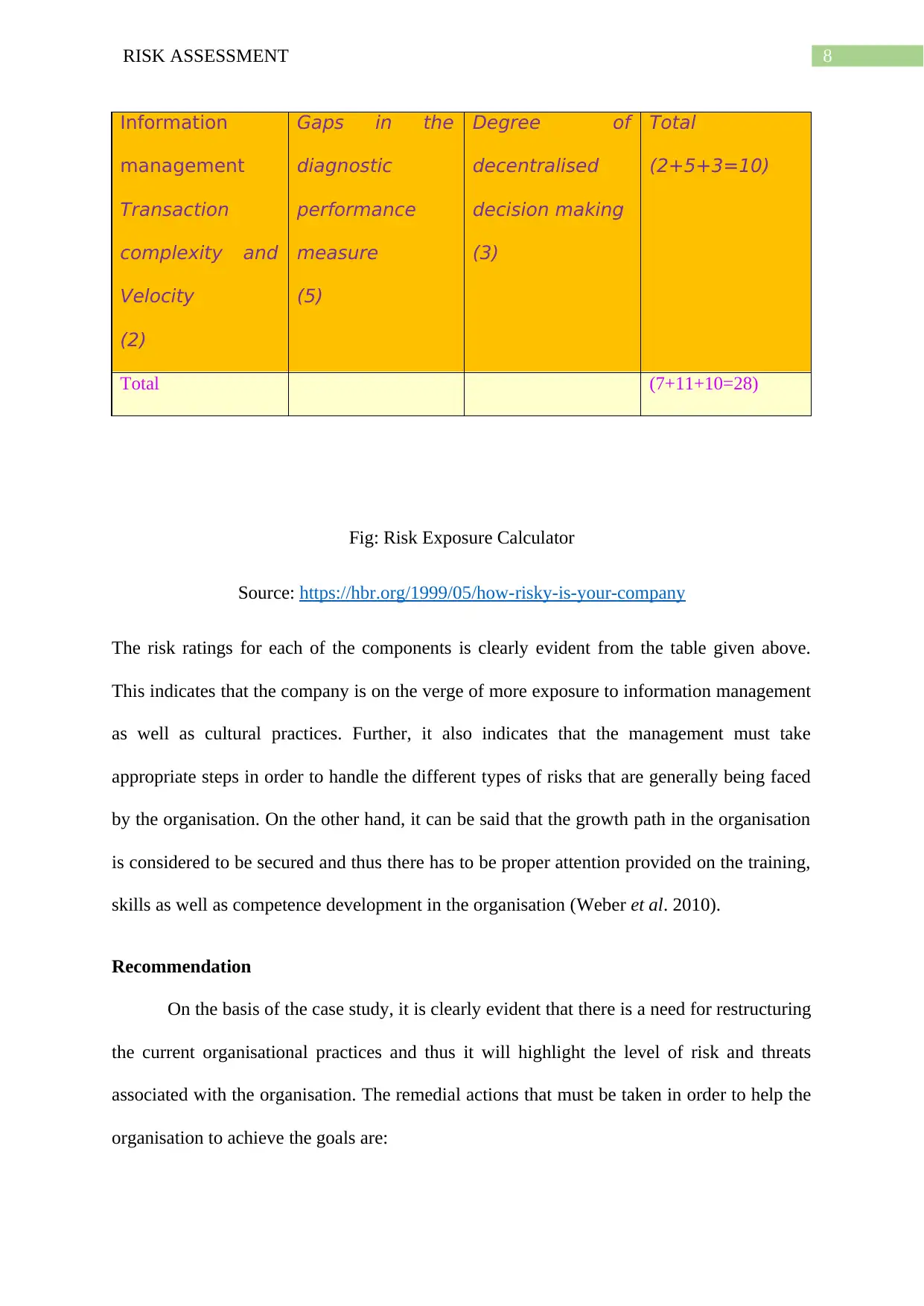
8RISK ASSESSMENT
Information
management
Transaction
complexity and
Velocity
(2)
Gaps in the
diagnostic
performance
measure
(5)
Degree of
decentralised
decision making
(3)
Total
(2+5+3=10)
Total (7+11+10=28)
Fig: Risk Exposure Calculator
Source: https://hbr.org/1999/05/how-risky-is-your-company
The risk ratings for each of the components is clearly evident from the table given above.
This indicates that the company is on the verge of more exposure to information management
as well as cultural practices. Further, it also indicates that the management must take
appropriate steps in order to handle the different types of risks that are generally being faced
by the organisation. On the other hand, it can be said that the growth path in the organisation
is considered to be secured and thus there has to be proper attention provided on the training,
skills as well as competence development in the organisation (Weber et al. 2010).
Recommendation
On the basis of the case study, it is clearly evident that there is a need for restructuring
the current organisational practices and thus it will highlight the level of risk and threats
associated with the organisation. The remedial actions that must be taken in order to help the
organisation to achieve the goals are:
Information
management
Transaction
complexity and
Velocity
(2)
Gaps in the
diagnostic
performance
measure
(5)
Degree of
decentralised
decision making
(3)
Total
(2+5+3=10)
Total (7+11+10=28)
Fig: Risk Exposure Calculator
Source: https://hbr.org/1999/05/how-risky-is-your-company
The risk ratings for each of the components is clearly evident from the table given above.
This indicates that the company is on the verge of more exposure to information management
as well as cultural practices. Further, it also indicates that the management must take
appropriate steps in order to handle the different types of risks that are generally being faced
by the organisation. On the other hand, it can be said that the growth path in the organisation
is considered to be secured and thus there has to be proper attention provided on the training,
skills as well as competence development in the organisation (Weber et al. 2010).
Recommendation
On the basis of the case study, it is clearly evident that there is a need for restructuring
the current organisational practices and thus it will highlight the level of risk and threats
associated with the organisation. The remedial actions that must be taken in order to help the
organisation to achieve the goals are:
⊘ This is a preview!⊘
Do you want full access?
Subscribe today to unlock all pages.

Trusted by 1+ million students worldwide

9RISK ASSESSMENT
Promotion of team value rather than the internal level of competition:
It is the responsibility of the current workforce level to consider the role of team value
rather than the internal level of competition. This will solve the issues of the clients as the
employees will focus on the provision of quality service. Further, it can be said that the
employees will also remain focused on the fulfilment of the organisational goals and
objectives accordingly.
The organisation of a detailed training session for the new joiners
There should be provision for the enhancement of the skill set of the new employees
who were hired by the management. It will enhance the competency level and thus the
managers must try to lay stress on the factors that will promote internal training in the
organisation. Further, there should be a proper level of consistency in the services offered by
the employees and thus it will promote customer satisfaction in the long run.
Providing training to the managers in relation to the consultation process
There should be a provision of proper training of the managers and this is possible
only through proper consultation. Further, there should be a proper level of interaction in the
organisation and thus the customers must try to carry out the interaction with the managers
through improved and better means. Thus, the implementation of better control practices will
help in the management of performance of the managers in an efficient way.
Promotion of team value rather than the internal level of competition:
It is the responsibility of the current workforce level to consider the role of team value
rather than the internal level of competition. This will solve the issues of the clients as the
employees will focus on the provision of quality service. Further, it can be said that the
employees will also remain focused on the fulfilment of the organisational goals and
objectives accordingly.
The organisation of a detailed training session for the new joiners
There should be provision for the enhancement of the skill set of the new employees
who were hired by the management. It will enhance the competency level and thus the
managers must try to lay stress on the factors that will promote internal training in the
organisation. Further, there should be a proper level of consistency in the services offered by
the employees and thus it will promote customer satisfaction in the long run.
Providing training to the managers in relation to the consultation process
There should be a provision of proper training of the managers and this is possible
only through proper consultation. Further, there should be a proper level of interaction in the
organisation and thus the customers must try to carry out the interaction with the managers
through improved and better means. Thus, the implementation of better control practices will
help in the management of performance of the managers in an efficient way.
Paraphrase This Document
Need a fresh take? Get an instant paraphrase of this document with our AI Paraphraser
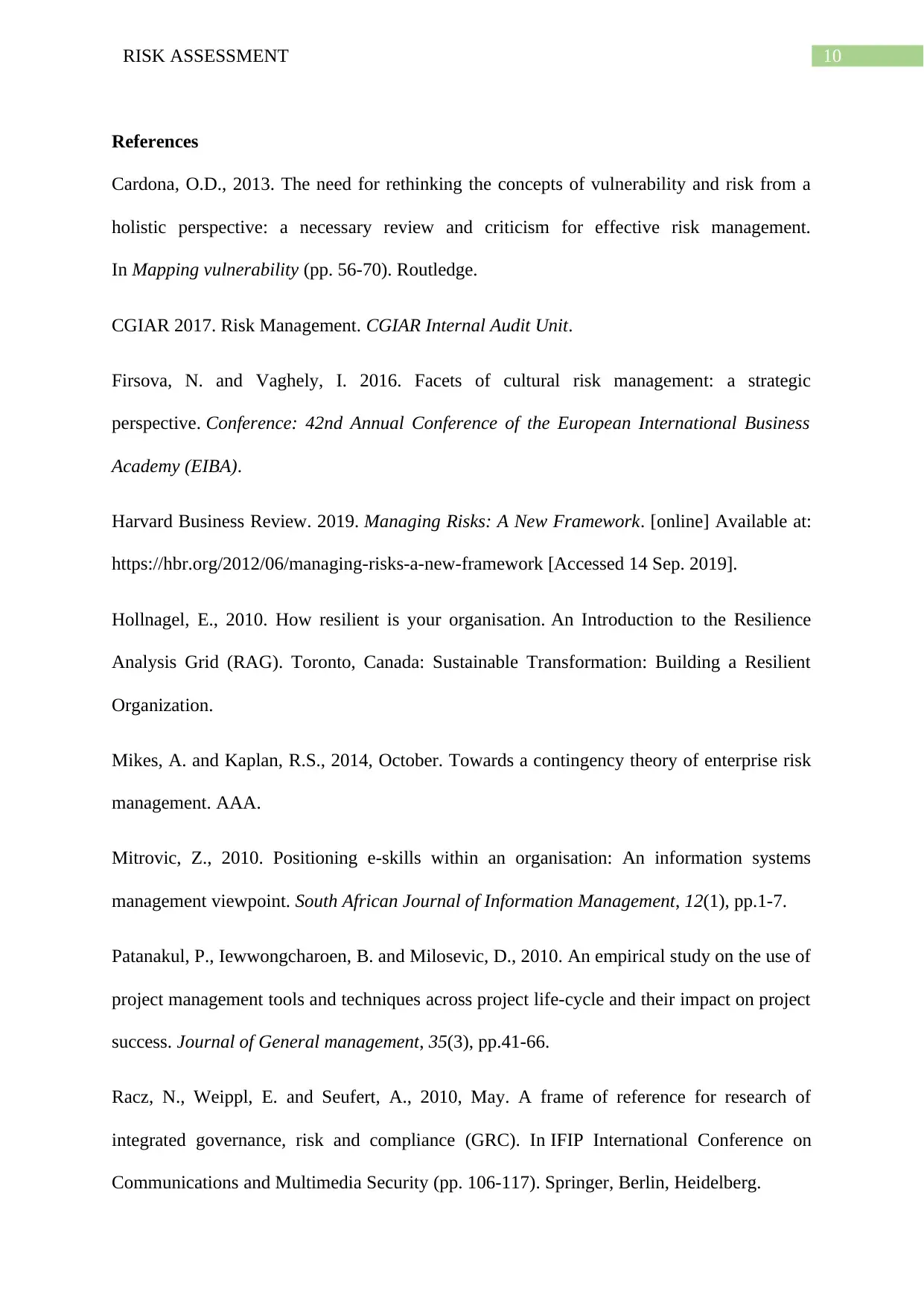
10RISK ASSESSMENT
References
Cardona, O.D., 2013. The need for rethinking the concepts of vulnerability and risk from a
holistic perspective: a necessary review and criticism for effective risk management.
In Mapping vulnerability (pp. 56-70). Routledge.
CGIAR 2017. Risk Management. CGIAR Internal Audit Unit.
Firsova, N. and Vaghely, I. 2016. Facets of cultural risk management: a strategic
perspective. Conference: 42nd Annual Conference of the European International Business
Academy (EIBA).
Harvard Business Review. 2019. Managing Risks: A New Framework. [online] Available at:
https://hbr.org/2012/06/managing-risks-a-new-framework [Accessed 14 Sep. 2019].
Hollnagel, E., 2010. How resilient is your organisation. An Introduction to the Resilience
Analysis Grid (RAG). Toronto, Canada: Sustainable Transformation: Building a Resilient
Organization.
Mikes, A. and Kaplan, R.S., 2014, October. Towards a contingency theory of enterprise risk
management. AAA.
Mitrovic, Z., 2010. Positioning e-skills within an organisation: An information systems
management viewpoint. South African Journal of Information Management, 12(1), pp.1-7.
Patanakul, P., Iewwongcharoen, B. and Milosevic, D., 2010. An empirical study on the use of
project management tools and techniques across project life-cycle and their impact on project
success. Journal of General management, 35(3), pp.41-66.
Racz, N., Weippl, E. and Seufert, A., 2010, May. A frame of reference for research of
integrated governance, risk and compliance (GRC). In IFIP International Conference on
Communications and Multimedia Security (pp. 106-117). Springer, Berlin, Heidelberg.
References
Cardona, O.D., 2013. The need for rethinking the concepts of vulnerability and risk from a
holistic perspective: a necessary review and criticism for effective risk management.
In Mapping vulnerability (pp. 56-70). Routledge.
CGIAR 2017. Risk Management. CGIAR Internal Audit Unit.
Firsova, N. and Vaghely, I. 2016. Facets of cultural risk management: a strategic
perspective. Conference: 42nd Annual Conference of the European International Business
Academy (EIBA).
Harvard Business Review. 2019. Managing Risks: A New Framework. [online] Available at:
https://hbr.org/2012/06/managing-risks-a-new-framework [Accessed 14 Sep. 2019].
Hollnagel, E., 2010. How resilient is your organisation. An Introduction to the Resilience
Analysis Grid (RAG). Toronto, Canada: Sustainable Transformation: Building a Resilient
Organization.
Mikes, A. and Kaplan, R.S., 2014, October. Towards a contingency theory of enterprise risk
management. AAA.
Mitrovic, Z., 2010. Positioning e-skills within an organisation: An information systems
management viewpoint. South African Journal of Information Management, 12(1), pp.1-7.
Patanakul, P., Iewwongcharoen, B. and Milosevic, D., 2010. An empirical study on the use of
project management tools and techniques across project life-cycle and their impact on project
success. Journal of General management, 35(3), pp.41-66.
Racz, N., Weippl, E. and Seufert, A., 2010, May. A frame of reference for research of
integrated governance, risk and compliance (GRC). In IFIP International Conference on
Communications and Multimedia Security (pp. 106-117). Springer, Berlin, Heidelberg.

11RISK ASSESSMENT
Shahzad, B. and Safvi, S. 2010. Risk Mitigation And Management Scheme Based On Risk
Priority. Global Journal of Computer Science and Technology, 10(4).
Simons, R. 1999. How Risky Is Your Company?. [online] Harvard Business Review.
Available at: https://hbr.org/1999/05/how-risky-is-your-company [Accessed 14 Sep. 2019].
Strelnik, E., Usanova, D. and Khairullin, I. 2015. Key Performance Indicators in Corporate
Finance. Asian Social Science, 11(11).
Von Krogh, G., Rossi-Lamastra, C. and Haefliger, S., 2012. Phenomenon-based research in
management and organisation science: When is it rigorous and does it matter?. Long Range
Planning, 45(4), pp.277-298.
Weber, O., Scholz, R.W. and Michalik, G., 2010. Incorporating sustainability criteria into
credit risk management. Business strategy and the environment, 19(1), pp.39-50.
Zakic, N., Papic, Z. and Radonjic, S. 2016. Meeting the coming organizational risk
challenges in human resources. International Review, (1-2), pp.109-116.
Shahzad, B. and Safvi, S. 2010. Risk Mitigation And Management Scheme Based On Risk
Priority. Global Journal of Computer Science and Technology, 10(4).
Simons, R. 1999. How Risky Is Your Company?. [online] Harvard Business Review.
Available at: https://hbr.org/1999/05/how-risky-is-your-company [Accessed 14 Sep. 2019].
Strelnik, E., Usanova, D. and Khairullin, I. 2015. Key Performance Indicators in Corporate
Finance. Asian Social Science, 11(11).
Von Krogh, G., Rossi-Lamastra, C. and Haefliger, S., 2012. Phenomenon-based research in
management and organisation science: When is it rigorous and does it matter?. Long Range
Planning, 45(4), pp.277-298.
Weber, O., Scholz, R.W. and Michalik, G., 2010. Incorporating sustainability criteria into
credit risk management. Business strategy and the environment, 19(1), pp.39-50.
Zakic, N., Papic, Z. and Radonjic, S. 2016. Meeting the coming organizational risk
challenges in human resources. International Review, (1-2), pp.109-116.
⊘ This is a preview!⊘
Do you want full access?
Subscribe today to unlock all pages.

Trusted by 1+ million students worldwide
1 out of 12
Related Documents
Your All-in-One AI-Powered Toolkit for Academic Success.
+13062052269
info@desklib.com
Available 24*7 on WhatsApp / Email
![[object Object]](/_next/static/media/star-bottom.7253800d.svg)
Unlock your academic potential
Copyright © 2020–2025 A2Z Services. All Rights Reserved. Developed and managed by ZUCOL.




